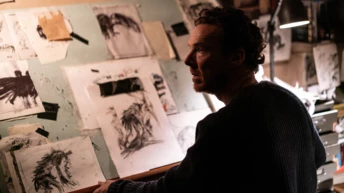
Save this storySave this storySave this storySave this story
In the literature about cruising from the late twentieth century, what stands out is the physical choreography of it. David Wojnarowicz, in his 1991 memoir, “Close to the Knives,” describes walking through abandoned warehouses on Manhattan’s west-side waterfront and “passing through shadowed walls and along hallways, seeing briefly framed in the recesses of a room a series of men in various stages of leaning.” Andrew Holleran, in his 1978 novel, “Dancer from the Dance,” conjures “dark clots of people who coagulate in empty lots, parked trucks, alleyways, worshiping Priapus under the summer moon.” And when Samuel Delany brings a female friend to witness the sexual scene at a late-night movie theatre in Manhattan, in his memoir “Times Square Red, Times Square Blue,” she observes, “There are a lot of people in here walking around . . .”
Delany’s memoir, which was published in 1999, was a lament for the shuttering of urban spaces where people, most of them men seeking men, once went for anonymous sexual encounters. Cruising, broadly defined, is the search for impersonal sex in public places—bathrooms, parks, saunas, movie theatres. It is as old as the existence of cities and traditionally a response to prohibitions on certain kinds of sexual relationships. “Exchanging brief glances or knowing nods at the wall of urinals, tapping the foot, dropping strands of wrinkled toilet paper,” Alex Espinoza writes in “Cruising: An Intimate History of a Radical Pastime,” from 2019. “We developed ways to communicate in a secret and coded language because we had to.” In the nineteen-sixties and seventies, cruising spots were listed in printed directories, such as Bob Damron’s “Address Book,” a self-published index of gay bars and “cruisy areas” around the country and, eventually, abroad. But in the wake of the AIDS epidemic, and the disappearance of many urban cruising grounds in response to health ordinances and gentrification, an in-person practice shifted online.
In “Petite Mort: Recollections of a Queer Public,” a 2011 collection of essays by writers and artists about public sex in New York City, edited by Carlos Motta and Joshua Lubin-Levy, the tone is unmistakably nostalgic. “There was every combination of guys there: from workmen, delivery boys, shop workers, executives, tourists, random dads, and well . . . you name it,” Aiken Forrett writes of a bathroom on a lower level of the World Trade Center. In the same collection, the legal scholar Katherine Franke chronicles “the afterlife of homophobia,” in which queer sex—following the decriminalization of “sodomy” in the 2003 Supreme Court case Lawrence v. Texas—was legitimatized, but also privatized. Franke calls for something of a reëxamination: “It’s time sex pushed back and resisted a hygienic sexual politics that aims to cleanse homosexuality of its raunchier elaborations.”
The arrival of Grindr, the first major dating app to use geolocation technology, in 2009, marked the start of a new era for dating culture. Its liberatory potential—sex freely available through one’s phone—captured the heterosexual imagination as much as the queer one, and OkCupid, Tinder, Scruff, and Growlr soon mimicked Grindr’s feed, which showed its users’ proximity to one another. But what was initially presented as a new freedom became, over time, its own form of labor: the effort of crafting a sexually appealing profile using select photographs and a short bio; the hours of scrolling. Today, Grindr is perhaps the most popular L.G.B.T.Q. social networks, with more than fourteen million average monthly users, but it has also been blamed for further driving gay life into private spaces—one study found a thirty-six-per-cent decline in the number of L.G.B.T.Q. bars in America from 2007 to 2019.
As the pursuit of sexual connections became increasingly digitized, a palpable longing began to emerge, not for the moral repression that brought cruising into being but for its qualities of anonymity and spontaneity. The novelist Garth Greenwell, in a 2016 essay in praise of cruising, wrote about spaces “in which the radical potential of queerness still inheres, a potential that has been very nearly expunged from a mainstreaming, homonormative version of gay life.” It was in the context of a nostalgia for something less overdetermined that, in 2018, a website called Sniffies.com started to take off.
Sniffies advertises itself as “a map-based app for gay, bi, trans, and curious cruisers.” You can access it through a web browser. There is no requirement to set up a profile, no obligation to upload photographs or even provide an e-mail address. Open it up, log on as an anonymous user, and you’ll get a real-time sexual map of your neighborhood. Sniffies allows users to notify others of their presence at public places such as parks, bars, and gyms, and to invite people to parties in private spaces. “Anybody else here?” a person might post, after arriving at a known cruising ground, many of which predate the internet. The first time I logged on, in Los Angeles, I saw a group gathered near what looked like a highway overpass.
People go on Sniffies not to chat, make friends, or meet for coffee, but with the expectation of immediate sexual gratification. A few users upload photographs of their faces, but most post photos of other body parts first, along with their physical specs, fetishes, H.I.V. status, and comfort level with being around drugs. As one Sniffies enthusiast, who called it “Grindr without the wink,” explained, “On Grindr, the third thing that you send is a picture of your genitalia; on Sniffies, it’s your profile picture.”
“The name came from the idea of sniffing people out, sniffing who’s around,” Sniffies’ founder, Blake Gallagher, who is based in Seattle, told me. In 2018, Gallagher, who was working as an architect but dabbled in computer programming, built a model of the site and posted about it in the Personals section of Craigslist. He posed as a fan, then watched as people logged on. The first two people on the map turned into four, then eight, then sixteen. “It just doubled and doubled,” he said. “I remember looking and realizing that, Wow, there’s only a couple dozen people on this map, they’re miles apart from each other but still in this very urban context of Seattle, and they’re coming back every day.” Soon, he began to notice an ad-hoc user base developing in Houston, then one in Columbus, Ohio, as people found out about the map and shared about it online. He said that it “just sort of organically began to grow.”
Sniffies users will often narrate their trajectory from trepidation to enthusiasm. “Just learned about Sniffies and trying to see if it’s worth it,” one post on Reddit reads. “And also if I’ll get murdered lol. All those headless XXX profile pics give me major back-in-the-day-Craigslist-vibes.”
John Smith (not his real name), a graduate student in art history, remembered a friend showing it to him at the Eagle, a gay bar in Los Angeles. He recalled it as “this awful little blue map”—a sea of sexually explicit photographs, each one belonging to a person potentially seeking an immediate connection. The friend he was with was on there, just another dick pic floating in a blue bubble over the coördinates of East L.A. “It’s, like, Oh, well, I guess we do know each other,” he recalled thinking.
A couple of years later, Smith moved from L.A. to Minneapolis for graduate school and began to view Sniffies differently. “All of the gay bars here suck,” he told me. Grindr wasn’t much better: “I’m sure you’ve heard the joke that a Minnesotan will give you directions to anywhere but their house.” He returned to the app his friend had shown him a few years before. “Sniffies functions slightly more anonymously,” he said. “In Minnesota, it’s just a little bit easier to use because that pressure of being known is removed.”
Even for those in bigger cities, Sniffies seemed to provide a sense of newfound possibility. “For a long time, I felt like maybe the best sexual period of my life was over,” a physician in L.A. told me. He was in a long-term open relationship, and both he and his partner sometimes went on Grindr to meet people. Grindr started crashing on his phone, so he began using Sniffies: “It really felt, like, Oh, I am a sexual being, I am desired, and I can fulfill some of these fantasies.” He described having a “sexual renaissance”—being able to look at the site’s map and see who he might want to hang out with while travelling around the city. “I can wake up on a Saturday and be, like, O.K., I don’t have a lot to do today, I should clean my house, but instead I’m just going to go out and have sex with someone.”
Before long, Sniffies was ubiquitous in most major cities. These days, many users compare the app, sometimes with skepticism, to Uber Eats. Fetishes can be specific—on the map of my neighborhood, the sexual trends have included “CMNM” (short for an asymmetrical encounter of “clothed male, naked male”) and “watersports”—but most of the desires being expressed are straightforward: people say what they offer and what they won’t do. (One person advised sex workers not to message him—he did not pay for “community dick.”) People advertise about missed connections; they check in at a local park; they indicate with a badge if they are willing to host a visitor. There’s a neighborhood bar in Bedford-Stuyvesant, Brooklyn, where people gather surreptitiously for a Sniffies-organized “DL night” (as in “down low,” slang for men who sleep with other men but identify as heterosexual). Attendees are instructed to rip the label on their beer bottles to indicate that they are interested in sex.
On a recent afternoon, I met Gallagher, Sniffies’ founder, in the company’s office in Bushwick, Brooklyn, in a converted factory where unlicensed parties used to be held. “I feel like Bushwick really embodies that Sniffies mentality of just a little underground, a little gritty and cool, kind of up-and-coming,” Eli Martin, the company’s chief marketing officer, told me.
Gallagher and I sat at a table covered with phrases scrawled in paint marker and branded “Hello My Name Is” Sniffies stickers, like the interior of a bar bathroom stall. Post-it notes on the room’s glass wall had ideas for upcoming episodes of “Cruising Confessions,” a podcast that Sniffies produces, which included “wrestling kink,” “cruising for daddies,” and “Jerrod Carmichael or other celeb.” Several coffee tables were decorated with a mix of high and low literature—a vintage pornographic paperback called “Crotch Bait” sat next to a Semiotext(e) edition of “I Could Not Believe It: The 1979 Teenage Diaries of Sean DeLear.” Sniffies prides itself as a product made “by enthusiasts, for enthusiasts,” and most of the people milling around the office were young and queer.
Gallagher, who is forty-four years old, wore a tip-dyed black sweatshirt, jeans, and high-tops. He still lives in Seattle, and was in town for a semi-annual meeting of all the company’s employees. (The fifty-plus-person workforce is mostly remote.) As an architect, Gallagher had worked for more than a decade on large-scale projects such as airports, hospitals, and residential towers. In the mid-twenty-tens, he picked up coding as a hobby, at first just teaching himself basic skills, “like how you would animate the Fibonacci spiral or something like that,” he told me, and then moving on to imagining products he might build. He was interested in the way that popular apps such as Uber and Pokémon Go were changing how humans navigate physical space—“these sorts of technological products that were layering themselves into our urban environments in ways that we had never seen before,” he said. Gallagher began tailoring his coding toward mapping, asking himself what a social network might look like if it were visible geographically. When he looked for a theme that would draw the users together, his mind turned to cruising—“a layer that existed within our urban experience that no one really talks about.”
Gallagher was influenced by an architectural theory known as prospect-refuge. First described in a 1975 book by the geographer Jay Appleton, it holds that people feel most comfortable in a place where they can take in the expanse of what’s around them without feeling exposed. On Sniffies, Gallagher observed, “you have full prospect, in the sense that you’re able to see your entire urban environment around you, and who’s existing in there with you on this theme, and then, at the same time, you have this element of refuge, where you’re able to anonymize your identity.” He continued, “You’re able to control your position on the map.”
At first, Gallagher ran the site on his own. By 2019, Sniffies had a big enough user base that Gallagher needed to hire technical support to handle the traffic. But he also knew that he needed to expand Sniffies’ reach. He brought in Martin, an old friend from Seattle who had done marketing work for Pepsi and Microsoft, to help. The two had met in 2007, after college, when they were both among the more sexually adventurous people in their friend group. “We were always exchanging stories,” Martin told me at the office. Martin, who is forty years old, was dressed like a Backstreet Boy, with a plaid shirt worn open over a tank top and wide-legged jeans, his short light-brown hair parted down the middle. Even though Gallagher couldn’t offer much more than equity, Martin was interested in building a company that affected him personally.
“The early adopters weren’t, I would say, your mainstream gay guys but probably more like these hypersexual kind of guys who wanted to essentially cruise and were willing to find these underground ways to do it,” Martin said. “Which is cool, but my goal was to make it, I hate to say, mainstream.”
Drawing on the mystique of cruising was one way of defining Sniffies in the marketplace. In recent years, there had been a resurgence of interest in cruising, with the publication of multiple histories, including Espinoza’s 2019 book; the rediscovery of novels such as John Rechy’s “Numbers,” from 1967; and photography collections about the Vale of Cashmere, in Brooklyn’s Prospect Park, and the Chelsea piers in Manhattan. (A gallery show, “Cruising in the Shadows,” about the history of cruising in New York, was on view this summer at ApexArt, in New York.) But it was still largely seen as a practice confined to the past.
“We needed to educate around cruising, because cruising also is kind of something that many people think of as deviant,” Martin said. He listed its associations with police stings and crime, and with “Cruising,” the 1980 movie that stars Al Pacino as an undercover cop infiltrating New York’s gay leather scene which was reviled as homophobic by L.G.B.T.Q. advocates. He told me that he had always wanted Sniffies to feel a little bit like a bar that you go to with open expectations. “I think when something becomes too oversaturated with that gay energy, the guys just become like wolves,” Martin said. The thing about cruising, he continued, is that it is about finding something slightly hidden. “So I would say, like, nongay events, like, say you’re at, like, a Katy Perry concert—or whatever,” he said, then added, “I don’t know why I said Katy Perry.”
In the beginning, Sniffies developed the product they wanted without trying to meet the guidelines of the app stores, which forbid sexually explicit material, and access was available only on web browsers, even on one’s phone. Limited by where it could reach its prospective audience, the company hired prominent queer photographers such as Sam Waxman, Slava Mogutin, and James Emmerman to produce photo shoots in locker rooms and office spaces for its in-house publication, Hush, and soon started selling Sniffies-branded clothes—wrestling singlets, jock straps—that I often see people wearing on New York City dance floors. By January of 2020, Sniffies had grown enough that Gallagher left his architectural career to run the company full time. When the pandemic hit just a few months later, the lockdowns almost seemed to help it expand faster, as people sought unconventional sexual encounters to minimize COVID risk, including meeting outside. (Martin described an infamous pandemic-era New York City Health Department guide that suggested safer sex through a barrier—known in some circles as a glory hole—as one “unexpected win.”)
Gallagher claimed that the Sniffies team developed its product “with blinders on,” without comparing itself with the competition, but another advantage it held was users’ fatigue with existing apps. Grindr is now sixteen years old, and other apps marketed toward the L.G.B.T.Q. audience don’t differ significantly from it in form. After passing through a series of ownership changes, Grindr went public in 2022. Since then, online discussions are rife with complaints by users about being inundated with playable ads for mobile games and getting locked out of key functions unless they upgrade to paid tiers. The company was also fined by the government of Norway and sued by a Catholic priest for selling data, including, in some cases, information about users’ location and H.I.V. status. (The more than five-million-euro fine in Norway was upheld by a Norwegian court; the priest’s case was stayed pending arbitration. Grindr disputes the allegations.)
Gallagher has said that what Sniffies brings is a resolution of other L.G.B.T.Q. apps’ “intent mismatch.” As a user of the app noted, “I think it’s understood that everyone there is probably there to fuck and not necessarily, like, ‘Would you like to go to the theatre with me?’ ” Perhaps one sign of Sniffies’ success was Grindr’s launch, in 2023, of its own browser-based web app and, this year, of a feature called Grindr Right Now, which allows users to advertise their immediate desires in posts that expire after an hour.
Sniffies, which makes money from a mix of subscriptions and advertising, now claims to be the largest L.G.B.T.Q. dating app after Grindr. (Subscriptions, for instance the $15.99-a-month tier, allow features such as live webcamming, and the ability to host groups and post in different cities.) In 2024, the app was translated into fourteen languages. Only thirty-three per cent of the people who fill out the profile about their preferences on Sniffies choose to describe themselves as gay. More than sixty per cent of the users are younger than thirty. The average person checks in twice a day, for an average of twenty minutes at a time. The most popular time to go on Sniffies, so much so that in the app’s early days it would crash the server, is Monday afternoon.
Sniffies is a predominantly masculine space, although it is inclusive of trans people. It recently added a field to display gender markers, and addressed the touchy subject of straight women at gay bars and in dark rooms, interviewing a bisexual male-female couple who cruise together on its podcast. Sniffies’ specificity in appealing to a particular queer tradition is part of what made it popular, but Gallagher hinted that the app might expand toward bisexual users, taking it perhaps in the direction of an app such as Feeld, which allows users to choose from a broad spectrum of gender identities and sexual proclivities.
But as it grows Sniffies is not immune from the fatigue produced by app-based intimacy in 2025. Several of the people I spoke with voiced frustration about the time spent scrolling for sex, the prevalence of drugs in the casual-sex scene, and the amount of advertising they are shown. Michael Speciàle, a writer in his thirties whose one-man show, “Bottoming for Jesus,” folds his experience on Sniffies and other apps into a larger story about accepting his sexuality, described to me the generational act of looking for sex online as following what he called “a pattern of ritualistic control seeking.” The apps have given him partners and friends, he told me, but lately he has been questioning the solace they offer. “I think when people feel politically powerless or emotionally isolated they seek rituals that can offer some sort of clarity and control,” he said. “I think some of this overlaps with what are called process addictions, where the repetition of seeking is to soothe something over.”
The young users of Sniffies may not know how much freedom they enjoy or how different the contours of gay life are today from twenty years ago, when a generation raised with a mortal fear of H.I.V. was still adjusting to the virus becoming a manageable condition. “When I was in my twenties, there were only two places that I could go to to have, you know, anonymous sex or something, and there was so much stigma around it that a lot of people my age kind of refused to be involved with it,” Leo Herrera, a New Orleans-based writer in his early forties who has appeared on “Cruising Confessions,” told me. “That stigma just really isn’t there anymore for people who are twenty-five.” In 2024, in part to bridge a knowledge gap between generations, Herrera self-published “(Analog) Cruising: A Manual.” The advice, which is organized by setting, includes following a “three-point system” for street cruising: “Lock eyes as you pass. Look back. If they look back, stop. If they stop too, walk toward them.”
Many have observed that the return of public sex is in large part a biomedical story. In July, 2012, the Food and Drug Administration approved Truvada, a pre-exposure prophylaxis effective at preventing H.I.V. infection colloquially known as PrEP. The antibiotic protocol known as doxycycline post-exposure prophylaxis, or Doxy PEP, can be taken after a sexual encounter to lessen the risk of contracting chlamydia, gonorrhea, and syphilis. In his book, Herrera describes “a massive paradigm shift through tools unimaginable to our ancestors: PrEP, H.I.V. undetectability, DoxyPEP, vaccines, GPS apps.” (Public-health authorities have advertised for these meds on L.G.B.T.Q. dating apps; Gilead, the manufacturer of Truvada, funds the Sniffies podcast, and people on Sniffies will often share if they’re taking PrEP in their profiles.)
These biomedical developments reduced the rate of new H.I.V. infections nationwide and by as much as thirty-six per cent between 2014 and 2023 in New York City, changing the calculus of sexual risk. In New York and other cities, dark rooms started returning to gay bars, and sex parties began advertising more openly. In the spring of 2022, during an outbreak of the mpox virus, a sexually transmitted disease that causes flu-like symptoms and a painful rash, public-health officials brought mobile vaccination vans directly to commercial sex venues in New York; during the mayoral administrations of Michael Bloomberg and Rudy Giuliani, police would arrive to raid such places. “It took so much trust to get them to believe that if the city brought the mpox-vaccine van there, that we weren’t gonna try to shut them down,” Joseph Osmundson, a molecular biologist and professor of public health at New York University who was involved in connecting the vans to sex parties, told me. At one event, he said, more than fifty per cent of the attendees got a dose of the mpox vaccine.
Whatever truce has been established between government authorities and the sexual underground is unlikely to last, however. Donald Trump, who, during his first term in office, pledged to end the H.I.V. epidemic in the United States by 2030 and recommitted funding to H.I.V. prevention, is reversing course in his second term. The Administration has halted hundreds of millions of dollars in funding for H.I.V.-related research in the United States, including trials for an mRNA H.I.V. vaccine. In April, it closed the lab that tracks sexually transmitted infections at the Centers for Disease Control and Prevention, firing all twenty-eight full-time employees and ending the monitoring of drug-resistant gonorrhea and other potential outbreaks, only to attempt to reverse the layoffs in mid-June; it also eliminated the Office of Infectious Diseases and H.I.V. Policy at the Department of Health and Human Services. In the C.D.C.’s April, 2025, H.I.V. Surveillance Report, the agency acknowledged that the government cuts had inhibited its ability to produce comprehensive data.
In 2007, Larry Craig, a Republican senator from Idaho with a record of supporting anti-gay legislation, was arrested for “lewd conduct” when he tapped his foot in the direction of a police officer in the bathroom of Minneapolis-Saint Paul Airport. (Craig pleaded guilty to a charge of disorderly conduct.) One advantage of Sniffies, the Minneapolis-based John Smith said, is that it “offers a hybrid way of telling you where it is that people are congregating, but also you can flag interest without necessarily having to get into the Larry Craig issue.” He doubted that what he called “non-bourgeois, nonidentity-based same-sex sexual practices” had ever lost their place in public—“I just don’t think that there were a lot of white literary types going off and sucking dick in a tree.”
Laws prohibiting picking someone up in a public place have frequently been found unconstitutional, but sometimes survive in the form of anti-loitering rules or traffic restrictions. In Los Angeles, a “NO CRUISING” sign that specified “TWO TIMES PAST SAME POINT WITHIN 6 HOURS IS CRUISING” hung in Griffith Park from 1997 until 2011, but similarly intentioned “NO U-TURN” signs in the neighborhood of Silver Lake were removed only last year. Having sex in public spaces, however, is typically outlawed by local ordinances. (New York State’s applicable rules include laws prohibiting public lewdness and exposure.) One Sniffies user told me that he just feels safer arranging encounters through the app rather than trying his luck on his own outside, which he used to enjoy. “I’m worried about the legality,” he said. “I don’t want to be caught and then be a sex offender or something.”
Sniffies says it takes the legal environment seriously, including following the state age-verification statutes recently upheld by the Supreme Court. Complaints by users of misconduct on the app are monitored by both A.I. and human moderators. The company told me that it does not sell or share any user data, including to advertisers, third-party venders, or external organizations, and that such data remains encrypted, but the map is as open to law enforcement as it is to the general public. In 2024, law enforcement used Sniffies in a sting in central Florida meant to crack down on sexual encounters in a public park, and online searches reveal cases of mistaken identity, of Sniffies users who claim to have thought they were meeting someone other than the person they exposed themselves to in a public space. When public places are listed in the app, users alert one another to the presence of law enforcement, urge people to pick up after themselves, and suggest the appropriate time to take, say, a “night time naked exhibitionist walk,” as one post put it.
“We’ve built Sniffies with safety and discretion at its core,” the company told me in a statement, “particularly in light of the real threats faced by LGBTQ+ people in many parts of the world.” But the company has also suggested that it is sometimes unfairly singled out for regulation for being a technology with a queer user base. After the new Sniffies app, which had launched in January on the iOS store, was removed in April, the company issued a statement. “Our iOS app was designed to comply with Apple guidelines,” Martin wrote in a post on social media. “In spite of this, our app was removed, while apps like Tinder, Grindr, Pure, DOWN, and CasualX, which promote casual meetups under a more sanitized ‘dating’ pretense, remain live.” Asked for comment, Apple referred me to their App Review Guidelines, specifically those that limit overtly pornographic material, which the guidelines define as “explicit descriptions or displays of sexual organs or activities intended to stimulate erotic rather than aesthetic or emotional feelings.” (The companies are in talks to finalize a version of the app that will satisfy both parties.)
Cruising evolved in a context of oppression, which is perhaps why it is such a current object of fascination. The federal government never bestowed a brushy area of a particular city park with any memorial signage; Target never sponsored a seasonal line of clothing honoring a Penn Station bathroom. It was a practice that, in its direct relationship to the forbidden, did not seek permission to exist, and its methods were traditionally communicated without speaking, without technology, without a declaration of allegiance to any particular identity or politics. “Maybe it’s enough to know public sex simply matters and to practice resisting the impulse to pull it apart and put it on display,” José Esteban Muñoz, the Cuban American academic and author of the theoretical work “Cruising Utopia,” wrote in “Petite Mort.” Maybe, with its hidden codes often invisible to those who are not looking, cruising looks like an elegant method of resistance. ♦
Sourse: newyorker.com







